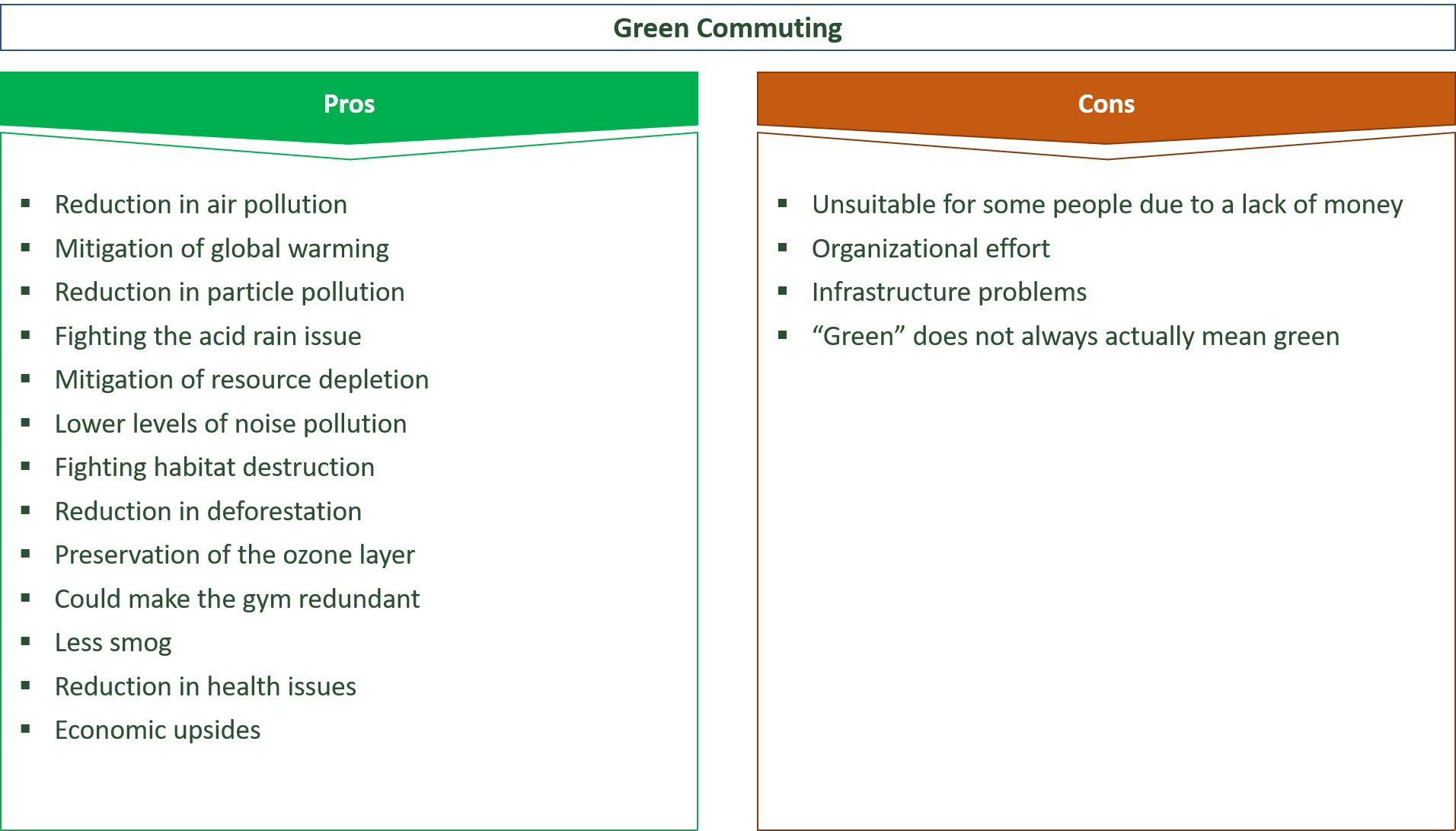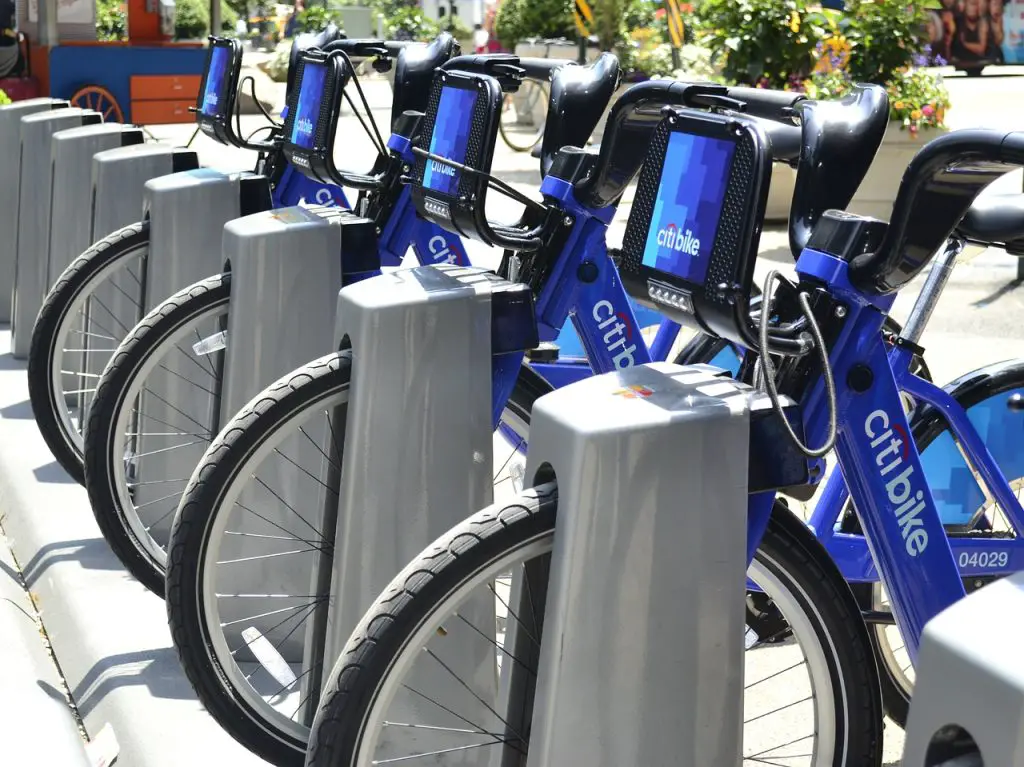“Every mom in a minivan, every person commuting – anytime they are on the road, they should be able to go into driver mode and give a ride to a neighbor. That’s how we achieve scale.”
Logan Green, Businessman
Green Commuting: Pros, Cons & Alternatives

Green commuting can be defined as going to work using alternative means of transport instead of conventional cars.
This can include the use of bikes or also to walk short distances to work.
Due to serious environmental problems like global warming and air pollution, green commuting will become even more important in the future.
In this article, the types, pros, cons and alternatives of green commuting are examined.
Audio Lesson
Contents
Types of Green Commuting
- Bike for green commuting
- Take a walk
- Use of electric scooters
- Public transport
- Use of electric cars
- Carpooling
Bike for green commuting
In order to make your commute greener, you could use your bicycle instead of your cars.
This is especially suitable for smaller distances of up to a few miles where you might actually be also even faster with using a bike.
For instance, while you will spend plenty of time in a traffic jam almost every day, you could save plenty of time by going by bike instead.
Especially in cities which are bike-friendly, commuting to work by bike is a quite good option to make your commute more eco-friendly.
Take a walk
If you live pretty close to your work, you could even try to walk there.
You could not only save fuel and money, you could also avoid several kinds of pollution associated with the use of conventional cars for commuting purposes.
Moreover, you might also enjoy walking a bit before going to walk in order to wake up and to be ready and motivated once you arrive at your workplace.
Thus, walking is another great way to get to work.
However, this may only suitable for you if you live pretty close to the company you work for since it would be too time-consuming and exhausting when it comes to long distances.
Use of electric scooters
Electric scooters become increasingly popular.
Especially for young people, they are considered a fast and fun way to get around.
In fact, for short distances, electric scooters may be superior to conventional cars not only from an environmental standpoint, but even from a time aspect since in many countries, you are allowed to use special lanes with electric scooters, which may prevent you from getting stuck in traffic jams.
Public transport
Public transport is still by far the most used alternative transportation method on a global scale.
It is much eco-friendlier compared to the use of cars since the emissions per capita will be much lower.
However, while public transportation may be suitable in some cities, there are many regions where the public transport infrastructure is quite bad and it would take far too long to get to work by bus or metro.
If you live in areas which are quite remote and do not have proper public transport, you should choose a different green commuting alternative.
Use of electric cars
The use of electric cars may also be regarded as a form of green commuting.
Even though electric cars are not entirely green at this point in time since power production still requires the use of fossil fuels on a large scale, they can still be considered to be more environmentally-friendly compared to conventional cars.
Thus, if you still want to commute to work by car, consider replacing your old car that is operated by fossil fuels with a more eco-friendly electric one.
Carpooling
Another great way to improve your ecological footprint while commuting is by using carpools.
This basically means that you pick up your colleagues on your way to work.
By doing so, the negative environmental impact per capita of using a car can be lowered since more than one person can be carried with one car.
Thus, the use of carpools can make commuting much more efficient.
Moreover, another advantage of carpools is that in some countries, you might also be eligible to use a carpool lane which may prevent you from getting stuck in traffic jams.

Pros of Green Commuting
- Reduction in air pollution
- Mitigation of global warming
- Reduction in particle pollution
- Fighting the acid rain issue
- Mitigation of resource depletion
- Lower levels of noise pollution
- Fighting habitat destruction
- Reduction in deforestation
- Preservation of the ozone layer
- Could make the gym redundant
- Less smog
- Reduction in health issues
- Economic upsides
Reduction in air pollution
Through green commuting, you can significantly reduce the level of air pollution in your region.
Since the use of conventional cars implies the emission of harmful gases into our atmosphere, you could save or even fully avoid those emissions by using an alternative green transport method.
For instance, going by bike does not imply any emissions at all.
Thus, the next time you wake up in the morning, consider using your bike instead of your car, especially if the distance to your workplace is quite short.
Mitigation of global warming
Since global warming is one of the biggest environmental issues humanity faces in our current times, it is crucial that we take proper measures in order to mitigate it.
This is also true when it comes to commuting to work.
Green commuting can significantly lower your greenhouse gas emissions and therefore also slow down the global warming process.
Reduction in particle pollution
In many big cities, particle pollution is a big issue.
The air quality is quite bad, which is not only annoying, but can also lead to serious health problems.
Through the use of green commuting methods, you can significantly reduce particle pollution and also all kinds of negative effects related to it.
Fighting the acid rain issue
Even though the acid rain problem is often belittled by the general public, acid rain can lead to serious consequences for humanity in the long run.
Crop yields can be lowered due to acid rain and also the local flora and fauna may suffer if our rain becomes too acid.
Since the emission of gases from our vehicles is a big cause for acid rain, we can mitigate the acid rain issue by green alternative commuting methods instead of using cars that are operated with fossil fuels.
Mitigation of resource depletion
Another advantage of green commuting is that it is also suitable to fight the depletion of natural resources.
Since conventional fuels are produced with the help of fossil fuels like oil, the use of conventional cars also implies the use of fossil fuels.
However, at one point in time, our fossil fuel reserves will be depleted and industries that still rely on fossil fuels might be in serious trouble.
Thus, by using green commuting methods, you can also protect our natural resources from depletion.
Lower levels of noise pollution
Noise pollution is another big issue, especially in big cities.
You can also contribute to less noise pollution by using alternative means of transport instead of using your car.
For instance, going by bike does not imply any noise pollution at all. If you live too far away from your workplace, you could also consider using electric scooters or even electric cars.
Even though they are not entirely green ways of commuting, they are still better in terms of the environmental impact compared to the use of conventional cars.
Fighting habitat destruction
The use of fossil fuels also implies serious levels of habitat destruction.
In order to be able to extract large amounts of fossil fuels out of the ground, large areas of land have to be used that will no longer be a suitable habitat for animals and plants.
Thus, by going by bike or by using alternative transport methods instead of conventional cars, you could also save our natural habitats and also fight the endangerment and extinction of species.
Reduction in deforestation
The extraction of fossil fuels out of our planet not only implies serious habitat destruction, it often also implies serious levels of deforestation.
Some crude oil reserves are located deep in the ground below large forest areas.
In order to be able to recover those reserves, many trees have to be cut down.
This further contributes to the global warming issue, since trees are a natural carbon dioxide storage space and deforestation leads to the emission of large amounts of greenhouse gases into the atmosphere.
Thus, by using green commuting practices, you could not only save our forests, but also mitigate the global warming issue.
Preservation of the ozone layer
Our ozone layer protects our animals and plants and also us humans from excessive sun exposure.
However, the emission of harmful gases due to the use of vehicles that are operated by fossil fuels contributes to the depletion of the ozone layer.
If the ozone layer becomes depleted, we would suffer from serious health issues like increasing chances for skin cancer.
Thus, it is crucial that we help to preserve the ozone layer by avoiding the use of cars and by commuting in a green manner.
Could make the gym redundant
You could not only protect our environment through green commuting, some forms of green commuting might also be rather exhausting.
However, this might be a good thing since you may no longer have to go to the gym.
Imagine going by bike to work every day. If you go by bike for a few miles, there would be no need to sit on a cross trainer in the gym anymore since you already completed your daily fitness routine by going to work and back home by bike.
Less smog
Through green commuting, you could also reduce the level of smog in a city.
Especially in big cities, while everyone goes to work by car, there is often a big cloud of smog settling over the city.
Some cities even had to react since regulatory limits had been exceeded.
In some cities, cars aren’t even allowed to enter the inner city if they emit too much emissions.
Thus, smog is a big issue and you could contribute to a reduction in smog by using alternative means of transport instead of your car.
Reduction in health issues
The air and particle pollution that is implied by the use of conventional cars can also cause serious health issues.
People in big cities are especially at risk for pulmonary diseases like asthma or lung cancer.
Moreover, bad air quality is also associated with an increased risk of heart conditions.
Thus, in order to protect our general public from those issues, you should refrain from using your car and use green commuting methods instead.
Economic upsides
Apart from all the environmental and health advantages of green commuting, it can also have significant economic upsides.
Many people spend large amounts of money on commuting over the course of a year.
If you use your bike instead of your car, you could save hundreds or even thousands of dollars in the long run.
This may give you an additional incentive in favor of green commuting when it comes to the question of whether it is worth it or not.

Cons of Green Commuting
- Unsuitable for some people due to a lack of money
- Organizational effort
- Infrastructure problems
- “Green” does not always actually mean green
Unsuitable for some people due to a lack of money
Even though green commuting has several advantages, it also implies some downsides.
Some people might not be able to afford green commuting.
They might live too far away from their work to go by bike.
They may also not be able to afford an electric car.
However, this group of people might still be able to use carpooling.
Even though it is not entirely green, using carpools is still better compared to commuting with your car alone.
Thus, even though there might be some financial issues that may prevent people to go for entirely green commuting, everyone of us can still make his or her contribution to a greener commuting behavior to a certain extent.
Organizational effort
Some people might also live in quite remote places and carpooling might not be a suitable option since their colleagues might live too far away.
Combined with financial problems, for this group of people, green commuting might not be an option and the use of conventional cars may be the only way to get to work in a timely manner.
Infrastructure problems
The overall infrastructure is still a big problem for green commuting in many regions.
For instance, electric scooters are often only available in bigger cities, but not in remote rural regions.
Thus, it makes it hard to use them as a suitable alternative for conventional cars when it comes to commuting purposes.
“Green” does not always actually mean green
Even though many products and services are declared as green in our current times, many of them are actually not entirely green.
For instance, electric scooters and cars still use energy that is produced with the help of fossil fuels.
Thus, the use of those electric vehicles still implies serious levels of greenhouse gas emissions until our global energy production will be secured through the use of renewable energies.
Therefore, you should pay close attention if your commuting behavior is really that green. If you are not sure, the greenest way to get to work is by going by bike or to walk for sure.

Green Commuting Alternatives
- Work from home
- Virtual conferences
- More working hours – fewer workdays
- Work flexible hours
- Use the most efficient route
- Drive slower
- Get proper and regular car maintenance
- Buy fuel-efficient cars
- Assure correct tire pressure
- Turn off your engine while waiting
Work from home
The most efficient alternative for green commuting is simply to work from home.
In many office jobs, working from home would be quite easy since most of the work is done through computers and with the help of the internet, communication is also quite easy.
Thus, by working from home, you could avoid any harmful gas emissions that are associated with conventional commuting, which could vastly improve your ecological footprint.
Virtual conferences
When it comes to client meetings, they could also be done through virtual conferences from home instead of attending the client’s office in physical form.
Through virtual conferences, there is no more need to commute since all kinds of presentations and negotiations could also be done with the help of conference software.
This could not only make your life more convenient, it also implies a significant reduction of all kinds of environmental problems that are associated with commuting.
More working hours – fewer workdays
You could also try to work more hours a day and take one more day off a week.
This would basically mean a 4 day work week with 10 hours a day instead of a 5 day work week with 8 hours a day for most people.
By working more hours but less days, you could reduce the need for commuting from 5 to 4 days, which would also mitigate the negative effects of commuting to a certain extent.
Work flexible hours
You could also ask your boss if it is possible to work flexible hours.
This means that you could get to and back from work sooner or later than most of the local population does.
By doing so, you could improve your ecological footprint and also save time since you would be less likely to get stuck in traffic jams.
Use the most efficient route
In order to commute in an eco-friendly manner, it is also crucial that you use the most efficient route when going to work by car in order to save fuel since the use of fuel implies all kinds of harmful emissions.
You can do this by using navigational clients which may show you the fastest and also the shortest distance to work and back.
Drive slower
Many people are in a rush and often drive quite fast on the freeways to get to work as fast as possible.
However, if you drive too fast, your car needs more fuel, which only implies higher spending on fuel, but also higher emissions.
Thus, if you are one of those speeders, try to slow down a little bit in order to make your commuting behavior eco-friendlier.
Get proper and regular car maintenance
It is also crucial that you get proper car maintenance on a regular basis.
Not only is it crucial for your safety, but also to avoid environmental pollution through oil leaks or also through unnecessary fuel consumption.
Buy fuel-efficient cars
When it comes to buying a new car and you do not want to get an electric car for your own reasons, you might still want to improve your ecological footprint by switching to a fuel-efficient car instead of a car that needs large amounts of gas.
By getting a fuel-efficient car, you can significantly lower your emission levels.
Assure correct tire pressure
Many people do not care about proper tire pressure, however, it is quite important, not only for your safety but also to drive as efficiently as possible.
For instance, with too low tire pressure, your car might need more fuel, which would contribute to several environmental issues.
Thus, always make sure that your tire pressure is in the correct range.
You can check this at most gas stations.
Turn off your engine while waiting
Many people also do not turn off their car engine while they are waiting for family and friends to join them.
However, this may lead to an unnecessary waste of gas.
Thus, if you have to wait for more than a minute, turn off your car engine to save gas and emissions.
Conclusion
Green commuting has many advantages, but it may not be suitable for some people due to a variety of reasons.
However, even for people that will not be able to use green commuting methods, there are still pretty good alternatives to how they can improve their ecological footprint.
Therefore, everyone of us can make his or her contribution in order to fight our environmental problems and to ensure a livable future for the next generations.
Sources
https://en.wikipedia.org/wiki/Commuting
https://www.sciencedirect.com/science/article/abs/pii/S0966692314001069
https://commute.org/ridesharing-services

About the author
My name is Andreas and my mission is to educate people of all ages about our environmental problems and how everyone can make a contribution to mitigate these issues.
As I went to university and got my Master’s degree in Economics, I did plenty of research in the field of Development Economics.
After finishing university, I traveled around the world. From this time on, I wanted to make a contribution to ensure a livable future for the next generations in every part of our beautiful planet.
Wanna make a contribution to save our environment? Share it!